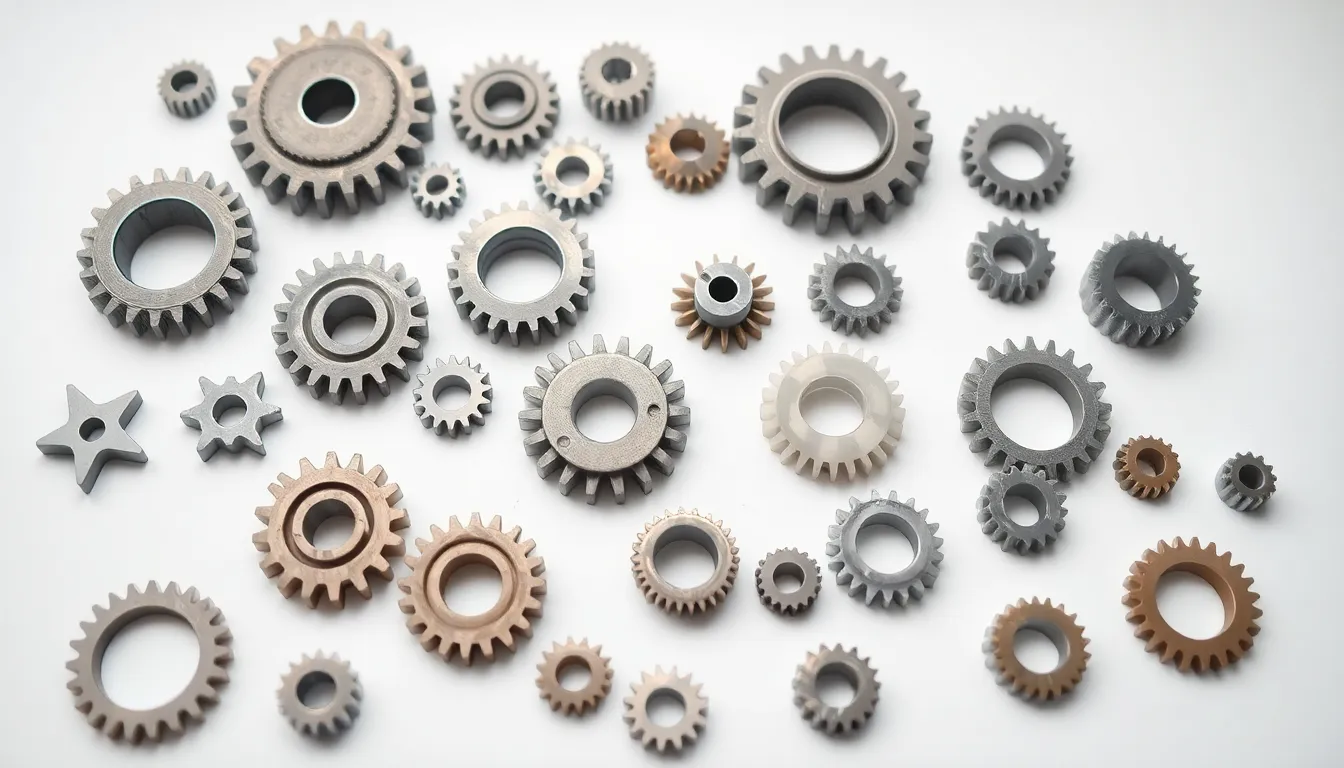Table of Contents
ToggleMechanical gears might seem like the unsung heroes of the engineering world, but they’re the real MVPs behind countless machines we rely on daily. From your trusty bicycle to complex industrial machinery, these little circular wonders convert motion and power with precision. They’re like the backstage crew of a concert—essential, but often overlooked.
Overview of Mechanical Gears
Mechanical gears serve as essential components in various machines, facilitating motion and power conversion with precision. They transmit torque and adjust speed ratios, ensuring optimal performance in applications ranging from bicycles to industrial equipment. A wide array of gear types exists, including spur gears, bevel gears, and worm gears, each designed for specific functions.
Spur gears, recognized for their simplicity, engage directly with one another, providing uniform speed and smooth operation. Bevel gears operate at an angle, enabling the transfer of power between perpendicular shafts. Worm gears, featuring a worm and a worm wheel, offer significant speed reduction and increased torque.
Material selection impacts gear performance. Common materials include steel, brass, and plastic, each chosen based on desired strength, weight, and cost factors. Industry standards guide the design and creation of gears, ensuring they uphold safety and efficiency in machinery.
Applications of mechanical gears span numerous fields. In automotive systems, they control engine output and power delivery. Robots utilize gears for precise movements, reflecting their versatility in technology. An understanding of gear ratios is crucial for engineers, as these ratios determine the relationship between input and output speeds.
Gears contribute to energy efficiency by minimizing friction and wear. Regular maintenance can enhance the longevity of gears, reducing downtime for machines. Notably, advancements in gear design and manufacturing technologies continue to refine their performance, fostering innovation across multiple industries.
Types of Mechanical Gears

Various types of mechanical gears contribute to different applications in engineering. Each type serves a unique purpose.
Spur Gears
Spur gears represent one of the most common gear types. They feature straight teeth and align parallel to the gear axis. Applications often include simple machines like clocks and bicycles. Efficiency marks their operation, as they transmit torque effectively and maintain a constant speed ratio. Manufacturing typically involves materials such as steel or plastic, based on required strength and cost.
Helical Gears
Helical gears incorporate teeth that angle toward the gear axis. These gears generate less vibration and noise compared to spur gears. With applications in automotive and industrial machinery, they ensure smoother power transmission. Helical gears allow for greater load capacity due to their tooth engagement, which increases over time. Various materials, including high-strength steel, enhance their durability and performance.
Bevel Gears
Bevel gears facilitate the transfer of power between shafts that intersect at an angle. They feature conical shapes, allowing for efficient torque transfer. Applications include automotive differentials and machine tools. The design allows for various configurations, such as straight, spiral, or hypoid bevel gears. Each variant offers differences in efficiency and noise levels. Typical materials for bevel gears include steel and brass, ensuring strength and longevity in demanding environments.
Applications of Mechanical Gears
Mechanical gears serve critical roles across various sectors, driving performance and enhancing efficiency.
Automotive Industry
In the automotive industry, gears are integral to transmission systems. They facilitate smooth gear shifts and optimize engine power for better fuel efficiency. Various gear types like helical and bevel gears support different functions, from transferring motion in manual transmissions to enabling precise gear ratios in automatic systems. Enhanced durability in gear materials ensures long-lasting performance under extreme conditions. Furthermore, innovations in gear design lead to quieter operations, contributing to a more pleasant driving experience.
Industrial Machinery
Industrial machinery heavily relies on mechanical gears for efficiency and reliability. Gears transmit power across different machine components, from conveyors to mixers. Spur gears are commonly utilized for straightforward applications, while helical gears find use in situations demanding high load capacities and reduced vibrations. The choice of materials, such as steel or durable alloys, improves the performance of gears in harsh environments. Enhanced gear designs also contribute to increased energy efficiency, minimizing waste and lowering operational costs for businesses.
Robotics
Robotics applications benefit significantly from mechanical gears. They provide precise control over movement and torque, essential for tasks requiring high accuracy. Various gear configurations allow for versatility in robotic arms and mobile platforms. Bevel gears facilitate motion transfer between non-parallel shafts, crucial in complex robotic systems. Gears made from lightweight materials assist in reducing overall weight while maintaining strength. Innovations in gear technology further enhance the responsiveness and efficiency of robotic systems, allowing for greater adaptability across diverse tasks.
Benefits of Using Mechanical Gears
Mechanical gears enhance efficiency by facilitating the precise transmission of power and motion. Torque is transmitted smoothly, allowing machines to operate effectively across various industries. Reliability stands out as an essential benefit, where well-designed gears maintain performance in demanding environments.
Durability is another advantage. Mechanical gears, constructed from robust materials like steel and brass, withstand wear and tear. Their longevity reduces the need for frequent replacements, ultimately lowering maintenance costs.
Noise reduction contributes to a better operating environment. Gears, especially helical types, minimize vibrations and sound, creating a more pleasant user experience. Effective speed control emerges as a key feature, enabling machines to adjust operational speeds according to specific needs.
Energy efficiency also plays a crucial role. Mechanical gears decrease energy loss by minimizing friction, leading to lower power consumption. These components optimize performance in automotive systems, where they improve fuel efficiency during operation.
Flexibility is evident in various configurations. Gears can be adapted for multiple applications, from robotics to industrial machinery, ensuring compatibility with numerous designs. Their application diversity makes them indispensable in tasks that require precision and control.
Cost-effectiveness often influences material selection for gear production. It’s essential to choose materials that offer the best balance of strength and affordability, contributing to overall project viability. Each benefit highlights the critical role mechanical gears play in enhancing machine performance across different sectors.
Challenges and Maintenance of Mechanical Gears
Mechanical gears face various challenges that can affect their performance. One major issue is wear and tear that occurs from continuous operation. Lubrication significantly impacts longevity, as inadequate lubrication leads to increased friction, generating heat and accelerating wear.
Alignment is crucial for smooth operation; misalignment increases stress on gear teeth and can lead to premature failure. Regular inspections identify misalignment and help in taking corrective action. Contamination from dust or debris also poses a significant risk. Using screens and filters reduces the likelihood of contaminants entering gear mechanisms.
Noise is another challenge, often indicating an issue with gears. Excessive noise can signal problems with lubrication or misalignment. Addressing these issues promptly prevents further damage and extends gear lifespan.
To maintain mechanical gears effectively, a robust maintenance schedule is essential. This schedule should include regular lubrication checks, cleaning procedures, and alignment assessments. Inspecting for cracks or wear on gear surfaces is also vital to ensure optimal performance.
Training personnel on proper handling and operation is critical. Educated operators can better detect issues before they escalate. Documenting maintenance activities keeps track of performance and aids in planning future maintenance.
Incorporating advanced materials, such as composites or treated metals, enhances durability and reduces the frequency of maintenance. Understanding manufacturer specifications ensures that gears operate under optimal conditions, avoiding excessive wear. Using optimal gear ratios also optimizes power transfer and efficiency, contributing to better maintenance outcomes.
Implementing these strategies can significantly improve the reliability and efficiency of mechanical gears in various applications. Regular maintenance not only prolongs gear lifespan but also enhances overall machine performance across multiple industries.
Mechanical gears are indispensable in the world of engineering and technology. Their ability to facilitate motion and power conversion underpins the functionality of countless machines. From automotive systems to industrial equipment and robotics, gears serve a vital role in enhancing efficiency and performance.
Understanding the various types of gears and their applications allows engineers to make informed decisions that optimize machine design. Regular maintenance and advancements in materials and technology further ensure that gears continue to perform reliably in demanding environments.
Ultimately, the significance of mechanical gears cannot be overstated, as they remain at the heart of innovation across multiple industries.




